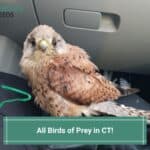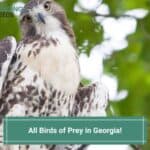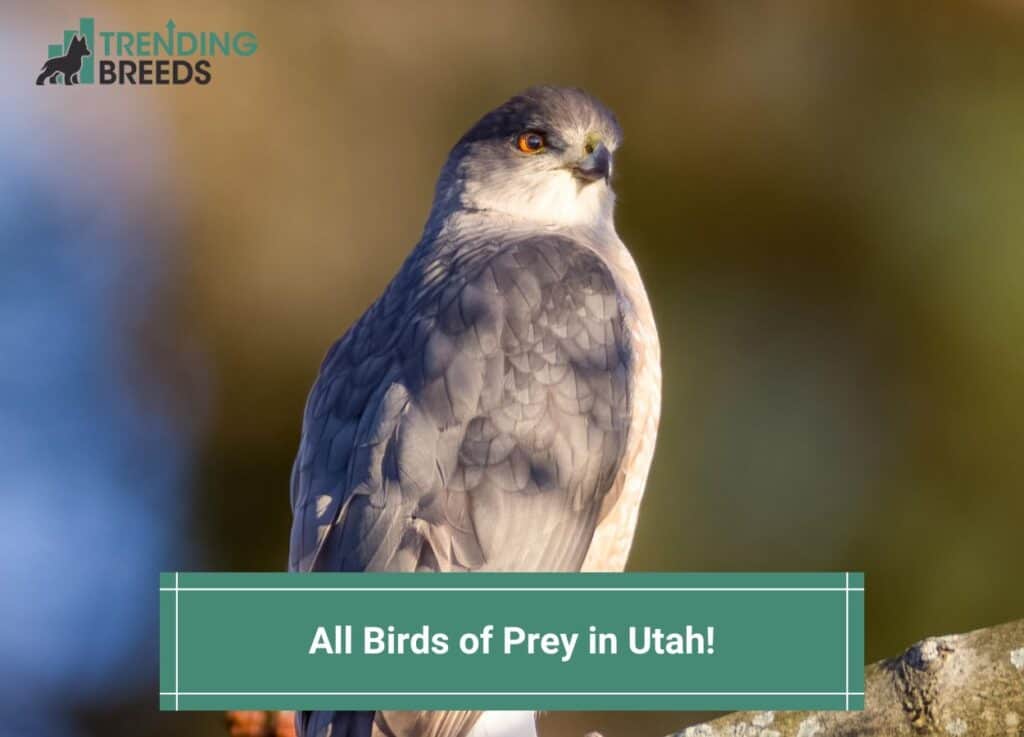
Are you a devoted bird lover and want to know more about the birds of prey in Utah? Well, you’ve come to the right place.
Utah boasts a magnificent variety of raptors that can be spotted throughout the state year-round.
This Southwest state is home to many kinds of birds of prey, including hawks, falcons, and owls.
Luckily, one can always enjoy spotting their favorite bird of prey in the national forests of Utah. Let’s find out more about the common raptors found in Utah.
Before you scroll further down this guide, check out these other bird-related articles: All Birds of Prey in PA and All Birds of Prey in Michigan.
Table of Contents
1. Ferruginous Hawk

Ferruginous Hawk Characteristics:
- Scientific Name: Buteo regalis
- Length: 20 to 28 in (51 to 71 cm)
- Weight: 32.0 to 80.0 oz
- Wingspan: 48 to 62 in (122 to 158 cm)
- Life Span: 16-20 years
- Conservation: Least concern
Ferruginous Hawks are one of the largest birds of prey in Utah. The name ‘ferruginous’ means ‘rust-colored.’
Ferruginous Hawks typically have two color forms: light morph birds and dark morph birds.
Light morph birds have rusty brown upperparts, while their heads and underparts are pale with rusty legs. They also have rusty markings on the underwings.
Dark morph birds are uniformly dark brown both on the upper and lower parts, with light areas on the wings. Both forms have grayish-white tails, large heads, and broad wings.
For habitation, Ferruginous Hawks usually avoid high altitudes, such as canyons and cliffs. They prefer open countryside as well as arid and semi-arid grasslands.
The Hawks also like middle-elevation plateaus and cultivated fields. Nesting takes place in open areas or trees.
Being common day hunters, Ferruginous Hawks prey on mid-sized mammals, mainly rabbits and squirrels, but they also hunt down reptiles, prairie dogs, snakes, as insects.
These hawks are known for their wide range of hunting techniques.
Their call is likened to a gull and makes sounds such as kree – a or ke – ah and harsh kaah, kaah.
Clutch size varies from 2 to 8 eggs with an incubation period of 32 days. Both sexes share incubation.
2. Cooper’s Hawk
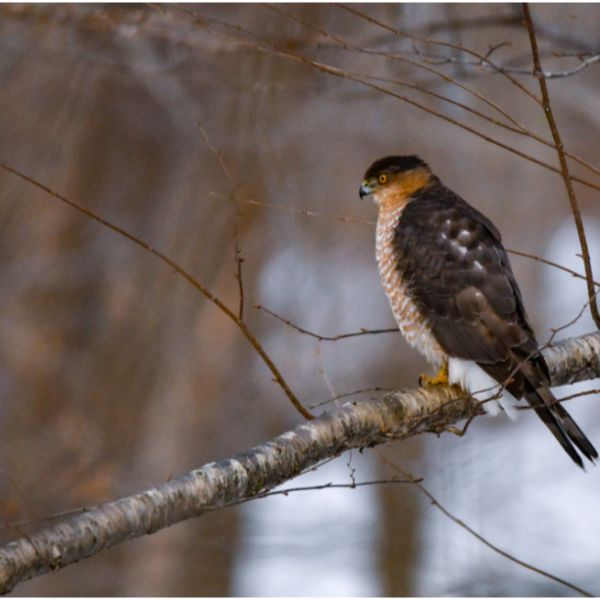
Cooper’s Hawk Characteristics:
- Scientific Name: Accipiter cooperii
- Length: 13.5-20 in (35-50 cm)
- Weight: 8-24 oz (220-680 g)
- Wingspan: 24.5-35.5 in (62-90 cm)
- Life Span: 10-15 years
- Conservation: Least concern
Boasting exceptional flying agility, Cooper’s Hawks are commonly spotted in Utah throughout the year.
These hawks are medium-sized birds and have a blue-gray, brown-gray back, and red-orange breast and also dark bands on the tail with a white tip.
They have a large head that projects well beyond the wings. There exists a sexual dimorphism, so females are larger than males.
Cooper’s Hawks are commonly found in dense forests, prying over potential prey. They are secretive creatures and live in dense forests.
In these habitats, they put their flying agility to the test by adeptly chasing small birds and mammals through the dense forest trees.
Cooper’s Hawks are notorious for killing small birds and mammals and have a diverse food selection.
These birds of prey can also visit your backyard in search of birds if you put out seeds for them.
The most common sound a Cooper’s Hawk emits is an alarm call that sounds like “kuck, kuck, kuck” or “cak-cak-cak.”
They lay 2-6 pale blue to bluish-white eggs per mating cycle and do not, commonly, mate for life.
The populations of Cooper’s Hawks declined remarkably during the late 1950s, but numbers gradually improved as conservation efforts began.
3. Rough-Legged Hawk

Rough-legged Hawk Characteristics:
- Scientific Name: Buteo lagopus
- Length: 18.5-20.5 in (47-52 cm)
- Weight: 25.2-49.4 oz (715-1400 g)
- Wingspan: 52.0-54.3 in (132-138 cm)
- Life Span: 15 years
- Conservation: Least concern
Colloquially known as the “Rough-legged Buzzard” or “Rough-legged Falcon,” the Rough-legged Hawk is a frequently seen, medium-sized bird of prey in Utah.
The feathers on their legs give them a distinctive, rough look, hence the name.
The plumage of Rough-legged Hawks is dark brown with many speckles.
They have a broad brown chest band with white underwings that are highly noticeable.
These hawks have long white tails with varying numbers of dark subterminal bands. The talons are relatively small, depicting the bird’s choice of prey.
Rough-legged Hawks are one of the few birds to hover regularly.
Their preferred habitat sites are marshes, prairies, and cultivated or agricultural areas with abundant rodents. Breeding sites include unforested, open grounds.
Rough-legged Hawks commonly prey on small mammals and are heavily carnivorous.
Their diet includes lemmings, voles, mice, mice, squirrels, and shrews.
In the case of a scarcity of a normal diet, these hawks also prey on larger animals such as jackrabbits, weasels, and prairie dogs.
Sexual maturity is attained at two years of age. Females lay 3-5 pale bluish-white eggs with a minimum incubation period of 31 days.
4. Swainson’s Hawk
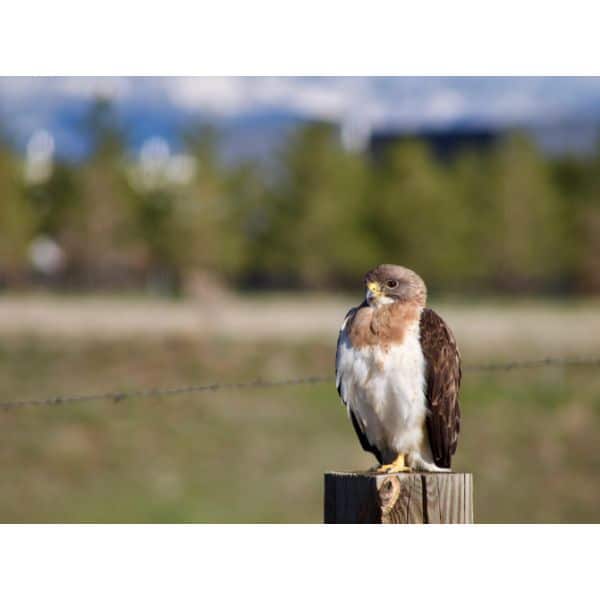
Swainson’s Hawk Characteristics:
- Scientific Name: Buteo swainsoni
- Length: 17–22 in (43–56 cm)
- Weight: 24.4-48.2 oz (693-1367 g)
- Wingspan: 46–54 in (117–137 cm)
- Life Span: 16-19 years
- Conservation: Least concern
One of the most frequently spotted birds of prey in Utah, Swainson’s Hawks are medium-sized raptors with characteristic long wings and short tails.
They can be spotted soaring in the sky or perched on electricity poles, fences, and trees in open areas.
Swainson’s Hawks have two color forms. The light morph is much more common (as high as 90% of the total population), and the dark morph Swainson’s Hawks are relatively rare.
The light morph adults have a noticeable white patch on the face and white throat with white underparts and a dark red spot on the chest.
They have dark flight features and light linings on the underwings, highly visible during flight. The tail is gray-brown.
Dark morph adults are dark brown colored with a light patch under the tail.
The tail is similar to that of the light morph adults. Females are usually larger and heavier than males.
Swainson’s Hawks commonly inhabit dry grasslands and prairies and prefer open areas.
They nest in trees, shrubs, cliff edges, and telephone poles and use twigs and sticks for nesting.
Swainson’s hawks are pretty even-tempered with their food and will eat anything, including grasshoppers, crickets, locusts, rodents, snakes, and rabbits.
They may also hunt down Burrowing Owls and American Kestrels.
Females lay 3 to 4 plain eggs with brown blotches with incubation periods between 34 to 35 days. The males bring food, whereas the females incubate.
5. Red-Tailed Hawk

Red-tailed Hawk Characteristics:
- Scientific Name: Buteo jamaicensis
- Length: 18 to 24 in (45 to 60 cm)
- Weight: 24-56 oz (700-1600 gm)
- Wingspan: 43-55 in (110-140 cm)
- Life Span: 25-30 years
- Conservation: Least concern
Red-tailed Hawks can be spotted quite easily, especially at a reasonable distance due to their distinctive short, wide tail.
Red-tailed Hawks are highly prevalent raptors and are sighted mainly in Utah, especially during winter.
The plumage of Red-tailed Hawks is highly variable among subspecies. It is brown or black with a whitish underbelly and a dark brown band across the belly.
They have broad, rounded wings. The tail of these birds is rufous brick red with dark black subterminal bands, which are variable in size.
They also exhibit sexual dimorphism, with females usually being 25% larger than males.
Red-tailed Hawks are known for inhabiting non-ideal environments from dense forests to sandy deserts, and thus, their diet is also extremely variable.
They nest mostly on high trees with open canopies and cliff edges.
They usually prey on rodents, small reptiles, rabbits and hares, ground squirrels, and fish and are highly opportunistic predators.
During courtship displays, the male hawks soar high in the sky, usually in circles, and make their characteristic, aggressive, raspy calls that we hear on television, commonly replacing the weak squeaking call of the Bald Eagle.
Clutch size is 2-3 white-brown blotched eggs. The incubation period lasts from 28 to 35 days and is primarily undertaken by females.
6. American Goshawk

American Goshawk Characteristics:
- Scientific Name: Accipiter atricapillus
- Length: 20.9-25.2 in (53-64 cm)
- Weight: 22.3-48.1 oz (631-1364 g)
- Wingspan: 40.5-46.1 in (103-117 cm)
- Life Span: 11-20 years
- Conservation: Least concern
American Goshawks can be more easily spotted in the national forests of Utah. They are highly secretive birds and aggressive predators.
American Goshawks are mistaken birds, especially for Cooper’s Hawk and Red-shouldered Hawks.
However, they are much larger and bulkier, with grayish plumage and short, broad wings.
American Goshawks have relatively more minor tails in comparison to their broad bodies.
They have yellow eyes with white stripes, and the beak is yellow with a black end. Moreover, these hawks have yellowish talons.
American Goshawks are residents of dense forests, especially coniferous and deciduous forests.
These birds of prey have special preferences regarding tree stands, which should be tall and old with dense canopy coverage that has proximal openings for hunting purposes.
They remain sedentary throughout the year. These birds are highly sensitive to humans and can get aggressive if their nests are approached.
American Goshawks are opportunistic feeders who hunt down medium-sized mammals and medium-sized birds.
Their diet comprises corvids, pheasants, woodpeckers, squirrels, thrushes, rabbits, and hares.
The populations of American Goshawks suffered greatly during the 1950s and 1960s due to pesticide pollution, but numbers have since recovered, and they are considered a species of least concern.
7. Western Screech Owl
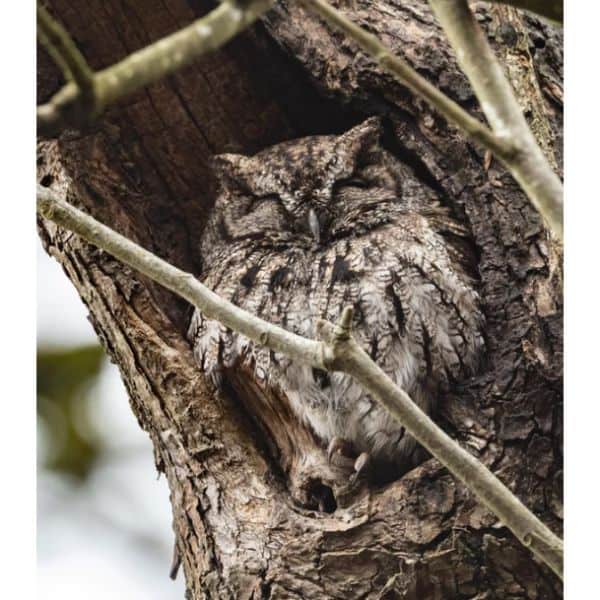
Western Screech Owl Characteristics:
- Scientific Name: Megascops kennicottii
- Length: 8.7 in (22 cm)
- Weight: 3.1 to 7.8 oz (88 to 220 g)
- Wingspan: 22 in (55 cm)
- Life Span: 8-13 years
- Conservation: Least concern
Western Screech Owls are small owls that are relatively easy to spot around Utah. These nocturnal birds can be seen in suburban areas and parks.
Western Screech Owls have multiple morphs depending on regions.
The plumage is brown or dark gray with multiple streaks on the undersides. This color specifically helps them with camouflage.
Western Screech Owls are Whiskered Owls with round heads and ear tufts. Their eyes and beak are yellow.
Western Screech Owls can be mistaken for Eastern Screech Owls, but they have larger feet and more streaks.
Western Screech Owls inhabit temperate forests, shrublands, deserts, agricultural fields, as suburban gardens.
They usually breed in open woods or at forest edges. Nesting occurs in tree cavities and cliff edges commonly.
With swift aerial dives, these nocturnal birds perch on unaware prey and usually feed on small mammals such as rats, mice, bats, flying squirrels, birds, and insects such as cardinals and sparrows.
They also hunt down reptiles and amphibians.
Western Screech Owls produce a clutch of 2 to 7 eggs. The male provides food, whereas the females incubate the eggs.
Although their population is gradually declining, the bird is still considered a species of least concern.
8. Great Gray Owl

Great Gray Owl Characteristics:
- Scientific Name: Strix nebulosa
- Length: 24 to 33 in (61 to 84 cm)
- Weight: 20-67 oz (580-1900 g)
- Wingspan: 55 – 60 in (140-152 cm)
- Life Span: 13-15 years
- Conservation: Least concern
Known to be the largest species of owl by length, the Great Gray Owl is a sedentary bird exhibiting little to no mobility between summers and winters.
They have classic round heads with gray faces and yellow eyes with dark linings on the circular periphery.
The upper part is gray with streaks, whereas the undersides are light with dark streaks.
Unlike other owls, Great Gray Owls do not have ear tufts and have the largest facial disk among all.
They have a “bow-tie” shaped white patch just beneath the beak. The tails are long, and they show sexual dimorphism.
These owls prefer to live near elevated sites, especially mountains, but may move down in search of prey.
Great Gray Owls never build their nests and use the nests of larger birds. They also nest in hollow cavities of trees.
Great Gray Owls hunt their prey on the ground by swooping down from elevated levels.
Their large facial disks and ears help them remarkably in the concentration of sounds.
These birds rely exclusively on rodents, including lemmings, pocket gophers, voles, squirrels, hares, and moles.
The usual clutch size is 4 eggs, which may vary depending on the abundance of food. The incubation period is about 28 to, and brooding lasts 2 to 3 weeks.
9. Burrowing Owl

Burrowing Owl Characteristics:
- Scientific Name: Athene cunicularia
- Length: 7.5–11 in (19–28 cm)
- Weight: 5–8.5 oz. (147–240 g)
- Wingspan: 20–24 in (51–61 cm)
- Life Span: 6-8 years
- Conservation: Least concern
Being rather a peculiar bird, the Burrowing Owl can be found easily in Utah. These birds have very distinctive plumage as well as uncanny living habits.
Burrowing Owls have flat facial disks that lack ear tufts. They have brown heads with white spots on their wings.
These owls have white chests and bellies with brown spots that vary in numbers depending upon the subspecies.
The eyes are very bright, with distinctive white eyebrows and a white chin patch. They show little to no sexual dimorphism.
As the name indicates, Burrowing Owls do not nest on trees but rather underground in burrows such as those left by Prairie Dogs.
They prefer open areas such as grasslands, deserts, and agricultural fields.
Unlike other owls, these birds are not strictly nocturnal and stay quite active during the daytime.
In adaptation to their living conditions, they have developed long legs for sprinting.
Burrowing Owls hunt at dawn or dusk. They have a highly variable diet, which ranges from large insects to small rodents.
They prefer eating ground Jerusalem Crickets, Ground Beetles, Vesper mice, House geckos, Grasshoppers, and Earthworms.
They typically breed in open grasslands, prairies, and man-made underground sites.
Females lay 4 to 9 eggs, then incubated for 3 to 4 weeks. These owls are relatively silent and occasionally make the whoo-woo calls.
10. Northern Saw-Whet Owl

Northern Saw-whet Owl Characteristics:
- Scientific Name: Aegolius acadicus
- Length: 6.7–8.7 in (17–22 cm)
- Weight: 1.9 to 5.3 oz (54 to 151 g)
- Wingspan: 16.5–22.2 in (42–56.3 cm)
- Life Span: About 7 years
- Conservation: Least concern
Northern Saw-whet Owl is one of the smallest birds of prey in Utah. They are migratory birds with a haphazard migration pattern.
They have a round, white face with cream or brown. The beak is relatively dark, and the eyes are yellow. Northern Saw-whet Owls don’t have ear tufts.
The upperparts are reddish brown with white spots, whereas the underparts are pale with dark patches.
They do not exhibit sexual dimorphism based on plumage but do so based on size, with the females being larger.
They possess porphyrin in their flight feathers, which emanate a neon pink color on exposure to UV light.
Northern Saw-whet Owls prefer coniferous forests but may inhabit mixed or deciduous forests in other seasons.
They live in cavities as well as nests of other birds.
Northern Saw-whet Owls can precisely locate their prey thanks to their facial features. This helps them hunt easily at night.
They mainly feed on small mammals such as mice, voles, and shrews. They may occasionally also eat bats, squirrels, moles, and sparrows.
These birds get their name because of the calls they make when alarmed, particularly resembling that of a saw being sharpened on a whetstone.
They make too-too-too calls. They lay 4 to 6 white-colored eggs per clutch.
11. Prairie Falcon

Prairie Falcon Characteristics:
- Scientific Name: Falco mexicanus
- Length: 14.5-18.5 in (37-47 cm)
- Weight: 15-39 oz (425-1106 g)
- Wingspan: 35.5-44.5 in (90-113 cm)
- Life Span: 2-5 years
- Conservation: Least concern
Prairie Falcons are one of the most commonly spotted birds of prey in Utah, especially around open areas with fewer trees.
They are well-known falconry birds.
Prairie Falcons sand-colored plumage with dark smears below. The head has a narrow mustache mark and a white line above the eyes.
The wing feathers are quite dark, and as a distinctive mark, the “wing pits “ and the underwings are black colored except for the wing’s leading edge.
The females can be twice the size of a small male.
Prairie Falcons are very similar to Peregrine Falcons, but the former is much lighter and can survive in harsher conditions even in the non-abundance of food.
These falcons prefer arid open countries, as well as prairie regions and deserts. They may also be spotted around towns.
Prairie Falcons like to hunt small mammals but don’t shy away from hunting down large birds ( such as geese).
Their diet comprises ground squirrels, prairie dogs, chipmunks, gophers, and rabbits. They may also eat pigeons, mallards, ducks, and sometimes reptiles.
Prairie Falcons make high-pitched kree-kree-kree or kik-kik-kik sounds.
These birds typically nest on cliff edges. Females lay up to 4 pinkish eggs with brown or purple blotches.
12. Peregrine Falcons
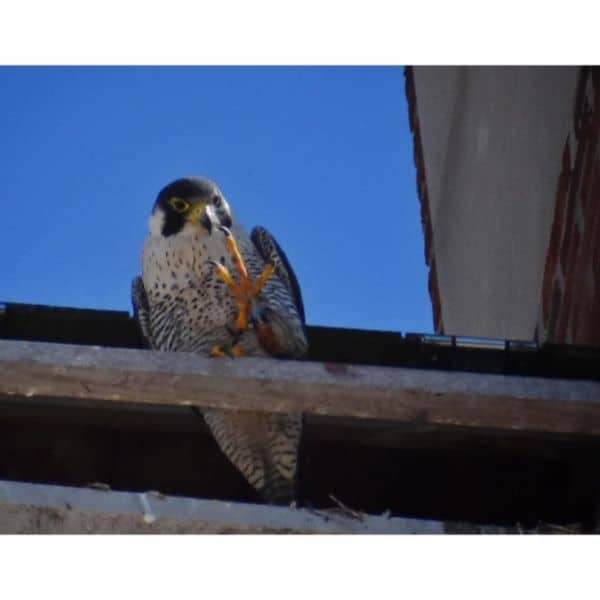
Peregrine Falcons Characteristics:
- Scientific Name: Falco peregrinus
- Length: 13-23 in (34-58 cm)
- Weight: 12-53 oz (330-1500 g)
- Wingspan: 29-47 in (74-120 cm)
- Life Span: 10-12 years
- Conservation: Least concern
Also known as “duck hawk,” Peregrine Falcon has the distinction of being the fastest bird in the entire world! And luckily, they can be found virtually everywhere in Utah.
Peregrine Falcons have long, pointed, bluish-blackish wings with darkened spots and black wingtips.
They have rusty, barred white undersides with brown bands. These falcons exhibit sexual dimorphism. The females are typically 30% larger than the males.
Peregrine Falcons are everywhere on Earth except in extreme polar regions such as Antarctica.
They usually inhabit cliffsides, mountain ranges, and riversides. These birds are also fond of nesting in tall buildings and thus can be located in cities.
These bird-eating raptors feed on medium-sized birds like pigeons, doves, waterfowl, parrots, seabirds, geese, gulls, and game birds.
Peregrine Falcons can reach up to 200 mph and are regarded as an exclusive member and a leading figure amongst falconry birds.
Peregrine Falcons are sexually mature at 1 to 3 years of age. These falcons typically lay 3-4 white eggs with brown or red markings.
13. Osprey
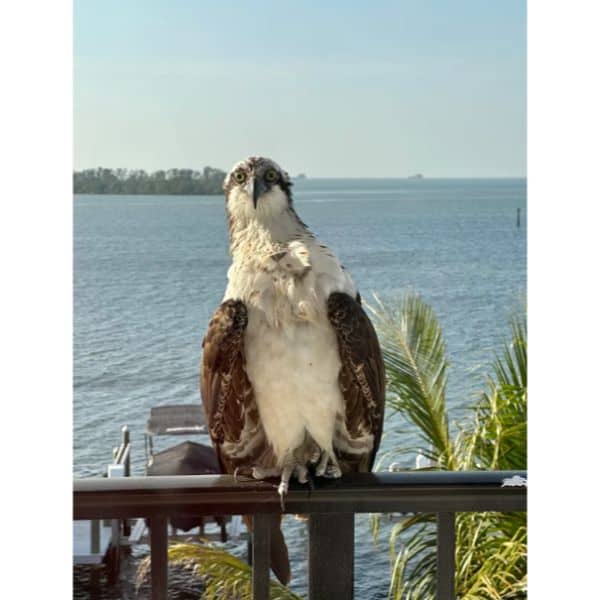
Osprey Characteristics:
- Scientific Name: Pandion haliaetus
- Length: 21 – 24 in (53 – 61 cm)
- Weight: 63.49 oz (1799 g)
- Wingspan: 54 – 72 in (137 -183 cm)
- Life Span: 7-10 years
- Conservation: Least concern
Ospreys are one of the most commonly spotted birds of prey in Utah, known for hovering regularly.
Ospreys are fierce-looking birds and are usually mistaken for hawks and falcons, hence the nicknames “sea hawks” and “fish hawks.”
The upper parts of Ospreys are deep, glossy brown, while the breast is white-brown, and the underparts are pure white.
The head is white with a dark mask across the eyes, reaching the neck’s peripheries.
They have short tails with long, narrow wings and uneven finger-like feathers. They have a reversible outer toe, which mainly helps in catching slippery fish.
Since their diet almost entirely comprises fish, Ospreys can be easily spotted near water bodies and riverbanks across Utah.
They nest on elevated surfaces such as treetops or cliffs. Ospreys are one of only six land birds with a worldwide distribution.
Ospreys are piscivorous, so fish consume 99% of what they consume.
Exceptional vision, closable nostrils, and reversible outer toes help them catch fish effortlessly.
Occasionally, Ospreys may also prey on rodents, rabbits, hares, frogs, and snakes.
Ospreys mate for life and lay one to four eggs per mating cycle with an incubation period of 35 to 43 days.
Frequently Asked Questions
What is the largest bird in Utah?
The California Condor is the biggest bird in the state.
Which is the fastest running bird?
Ostriches are the fastest running bird in the world.
What bird can fly backward?
Hummingbirds can fly backward.
All 13 Birds of Prey in Utah
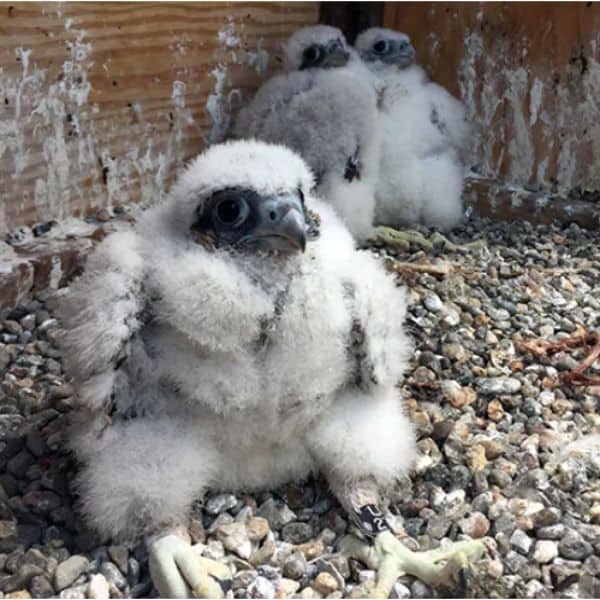
From an exclusive list of hawks to a variety of owls and falcons, the state of Utah is surely a paradise for bird watchers.
One can not help but wonder at the sheer number of unique raptors that can be found in Utah, every single bird of prey unique in its appearance, habitat, behavior, and diet.
Be it a bird enthusiast or a random local, one can relish the sights of a plethora of different birds of prey in Utah.
This guide should surely help you out in spotting various birds of prey the next time you step out of your house. Happy Bird Sighting!
If you find this guide, “All Birds of Prey in Utah,” informative and helpful, you can check out these other bird-related articles from our team:
You can learn more about birds by watching “All 13 Birds of Prey & What Makes Them Incredible” down below:

